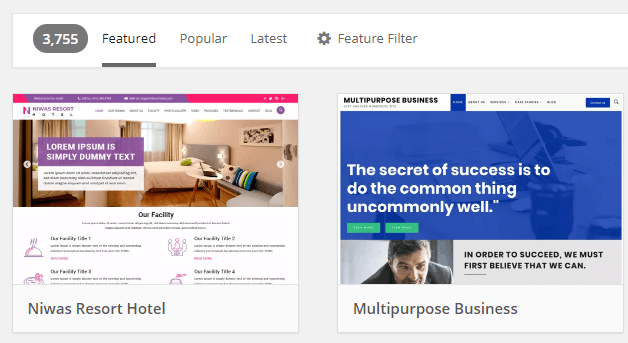
How to Add a WordPress Blog to an Existing Website: A Step-by-Step Guide
A lot of businesses find that running a blog is a great way to boost traffic to their websites. That traffic, in turn, is something you can turn into additional business. The problem is that setting up a blog for an already existing site can take a bit of work.
If you use WordPress, however, you’re in luck. With this Content Management System (CMS), you can easily set up a new website to act as your blog, and link it to your main site. You can even do this using a subdomain or subdirectory, so you can still use your primary domain.
In this article, we’ll teach you how to add a blog to your existing website. We’ll go over two potential methods, and explain all of the steps involved. Here’s what we’ll cover to get your blog up and running:
Why Add a WordPress Blog to Your Website?
Imagine you have a website, but you’re looking for a way to take it to the next level. That’s where adding a WordPress blog to your website comes into play, and it brings a multitude of benefits.
First and foremost, having a blog on your website can significantly boost your online visibility. Search engines love fresh, relevant content, and with each new blog post, you’re feeding these search algorithms exactly what they’re “looking” for. This can lead to higher search engine rankings, making it easier for potential visitors to discover your website.
Beyond improving your search engine presence, a blog also allows you to showcase your expertise. You can share insights, knowledge, and solutions related to your industry or niche. This establishes your website as a trustworthy source of information and positions you as an authority in your field.
Moreover, a blog encourages engagement. Readers can leave comments, share your posts on social media, and connect with your content, creating a sense of community around your brand.
What’s great is the flexibility a WordPress blog offers in terms of content. You can diversify your content by creating informative articles, engaging videos, or eye-catching infographics. This caters to different preferences and learning styles among your audience.
Monetization is another perk. You can explore various revenue streams through your blog, such as affiliate marketing, sponsored content, or directly selling your products or services through eCommerce extensions such as WooCommerce.
WordPress, with its user-friendly interface, simplifies blog management. It’s designed to be mobile-friendly, ensuring a seamless experience on various devices. Plus, WordPress provides valuable analytics tools to help you understand visitor behavior and refine your content and marketing strategies.
In essence, adding a WordPress blog to your website is like supercharging your online presence. It attracts more visitors, establishes your authority, fosters engagement, and opens up monetization opportunities—all with a user-friendly platform that keeps pace with modern web development.
How to Add a WordPress Blog to Your Website
Adding a WordPress blog to your website can indeed be beneficial for your larger digital presence, and the good news is, it’s not a particularly complicated process.
In fact, WordPress is renowned for its user-friendly interface, making it accessible to individuals with varying levels of technical expertise. Whether you’re a seasoned web developer or a beginner, you’ll find the platform intuitive, and this simplicity means you can start reaping the rewards of enhanced visibility, engagement, and authority without the headache of navigating complex technical hurdles. Let’s dive into the steps below!
Choose a Subdirectory or Subdomain
The best way to add a blog to your existing WordPress website is to create a new site altogether. You can do this while still using the same domain as your main site, by installing WordPress in a subdirectory or a subdomain.
Here are two examples of what that might look like:
- Subdomain: blog.yourwebsite.com
- Subdirectory: yourwebsite.com/blog
From a functional standpoint, both approaches work just the same. There’s some debate about what the best option is, but as far as Google is concerned, it treats subdomains and subdirectories equally.
If you don’t have a personal preference, we suggest that you use a subdomain, as it’s the most efficient solution. We’ll show you how to use both approaches, however, so you can choose for yourself.
Installing WordPress in a Subdomain
First up, let’s look at how to set up your blog using a subdomain. This is the approach we recommend here at WP Engine, and it only takes three steps.
Step 1: Set Up a Subdomain
How you approach this process will depend on which web host you use. For example, a lot of hosting providers use cPanel, which includes an option to set up subdomains with just a few clicks.
If you’re a WP Engine user, you can navigate to your User Portal and choose the Add Domain option. Then, you just need to choose the domain you want to use, and pick a name for your subdomain.
After your subdomain is ready, you can install WordPress through your user panel. Simply go to the Installs tab in your dashboard, and choose the Add Install option. Then, you’ll be able to set up a new WordPress installation on your subdomain.
Keep in mind that if you plan on running more than two WordPress sites, it might be in your best interests to use a Multisite setup. With multisite, you can easily add more installations using their own subdomains or subdirectories, all from your WordPress dashboard.
Step 2: Choose a Theme to Match Your Existing Site
Whichever approach you choose to create your blog, you’ll also need to set up a theme for it. Ideally, this theme will share a similar style to your main website. That way, people won’t notice that they’re navigating through two different sites.
You’re free to pick whichever theme you want, of course. If you’re not sure where to start, the WordPress Theme Directory is always a great resource:

Within, you’ll find thousands of options. We recommend that you stick to those with positive reviews and recent updates. You’ll also want to preview any theme you’re interested in, to make sure it’s mobile-friendly.
Along with choosing a matching theme, it’s also best to use the same fonts throughout your main website and blog (for consistency’s sake). To learn how to do that, check out our full guide on how to change your WordPress blog fonts.
Step 3: Add Menu Links
To further maintain the illusion that your primary website and blog are two parts of a whole, they’ll need to share identical menus. That process involves two steps:
- Adding a link to your blog to your website’s navigation menu.
- Duplicating your main site’s menu on your blog itself.
Adding menu items to WordPress is quite simple. If you’re not familiar with the process, check out this guide on how to create WordPress menus.
Installing WordPress in a Subdirectory
Before we wrap up, let’s look at the other way to set up your WordPress blog. Keep in mind that WP Engine does not support the use of subdirectories for WordPress installations. This means that if you’re a WP Engine user, you’ll need to stick with subdomains.
Step 1: Install WordPress in Your Blog Subdirectory (And Configure It)
The process of creating a subdirectory will vary depending on your host. However, in most cases, you should be able to find an option for it within your control panel.
After that, all you have to do is choose the domain you want to use, and pick a name for your subdirectory. Then, it’s time to install WordPress on it, which you should also be able to do from your user panel.
Just as with the previous approach, you can also use multisite to add WordPress websites using subdirectories, all without leaving your dashboard. When your site is up, remember to update your permalink structure right away, so that your blog’s URLs look nice.
Step 2: Choose a Theme
As we explained before, your WordPress blog’s theme should match the style of your main website. Otherwise, people will be confused when they make the jump from one to the other.
To a visitor, everything should appear to be a single website, from layout to fonts. We already covered this process in depth earlier, so feel free to refer back to that section for more details.
Step 3: Create Your Menu
The main way visitors will move through your website is by using its navigation menu. Both your primary website and blog will need their own menus. If those menus are identical, visitors shouldn’t notice that they’re moving from site to site.
To achieve this, you’ll need to add a link to your WordPress blog to your main website’s menu. Once that’s done, you’ll want to copy that entire menu, and add it to your WordPress blog.
If you choose a theme that matches your site’s style, once you add your new menu your blog should be a perfect match.
Add a WordPress Blog to Your Website With WP Engine
Adding a WordPress blog to your website can be a smart decision for your business. With a regularly-updated blog, you can position your company as an authority, and drive more traffic over to your main site.
Across WP Engine’s wide library of WordPress resources, you’ll find a ton of content you can use to learn how to launch a WordPress blog, using either subdomain or a subdirectory. Plus, we’ll also teach you how to edit every aspect of your blog, from its fonts and colors to larger design concerns.
If you sign up for one of our plans, you’ll get access to all of that, as well as industry-leading WordPress hosting. Visit WP Engine or speak to a representative today!
